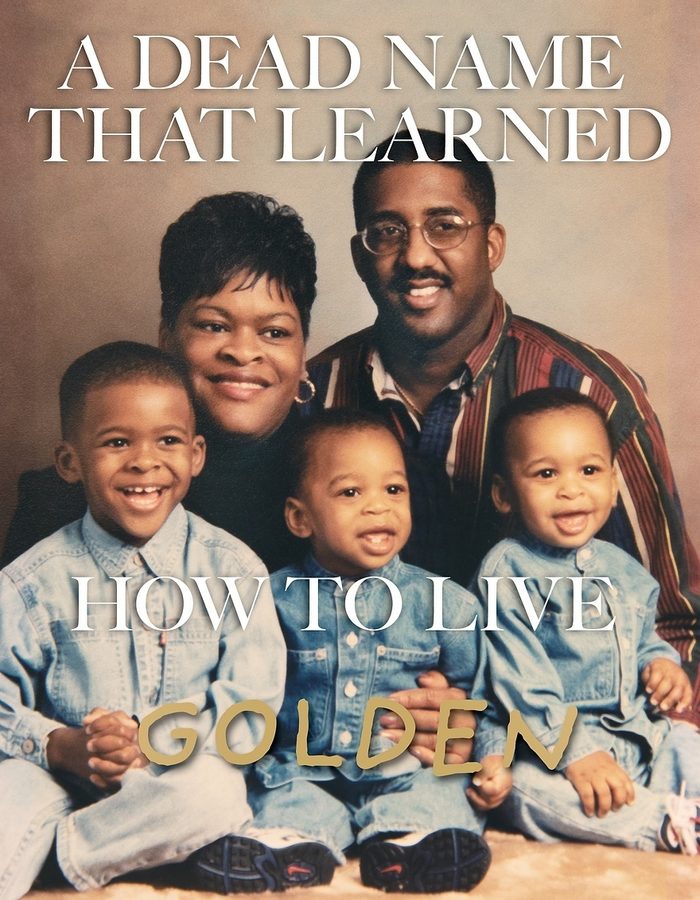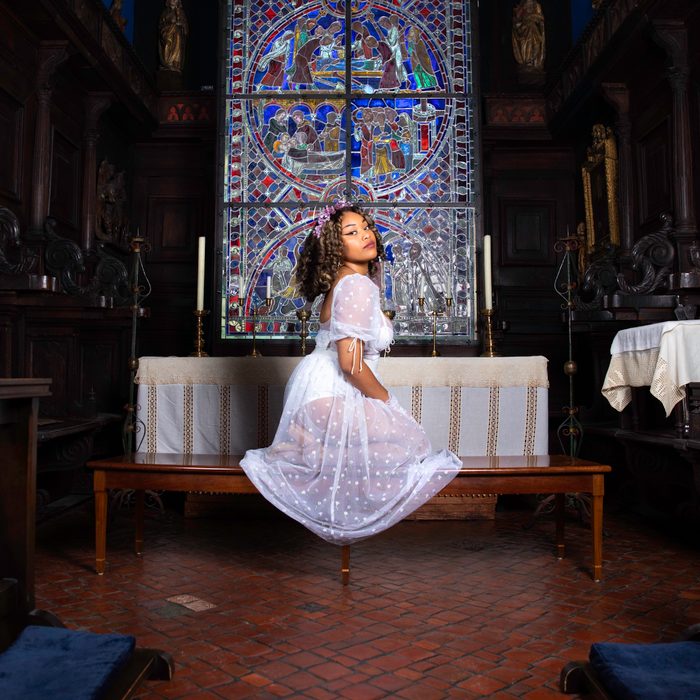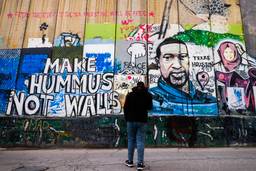Golden on Learning How to Live as a Black, Queer and Trans Artist from the South
“There’s so much politicizing of trans lives and at the heart of it, I just want to wear my dress.”
Sherell Barbee

In 1985, poet and essayist June Jordan wrote this ode to Phillis Wheatley:
Come to this country a slave and how should you sing? After the flogging the lynch rope the general terror and weariness what should you know of a lyrical life? …belonging to no one, but property to those despising the smiles of your soul, how could you dare to create yourself: a poet?
Around age 7, Wheatley was taken from her home in West Africa and trafficked to Boston, where she was sold into slavery. At a time when it was illegal for many Black people to read and write in the United States, Wheatley became the first Black American to publish a book of poetry. Her work touched on topics from abolition and religion to family life.
Black poets in Boston continue Wheatley’s legacy today by bringing a raw vibrancy to the reality of life in the city. Because the Boston arts community is small and tight knit (I lived in Boston from 2018 to 2021), it isn’t unusual to hear about a poet by word of mouth.
I first heard about Golden—a friend of a friend’s friend whose name was sprinkled in conversation every now and then — with words like sweet to describe their personality, talented to describe their poetry and photography, and passionate to describe their stage presence at local slam poetry events. “Of course,” people said, when the city announced Golden would take one of its few, coveted 2020-2021 artists-in-residence spots.
I finally got the chance to meet Golden via Zoom this year, where we discussed their debut poetry collection, A Dead Name That Learned How to Live, their experience as a trans and queer Black artist from the South, and their photography. Golden uses portraits of their self, family and friends to posit Black subjects at the forefront of intriguing backdrops. Following our Q& A is a poem from Golden’s book, which touches on how Golden’s mother grappled with her child redefining their gender.
Try to imagine: one’s mere existence a topic up for political debate, one’s selfhood granted or denied by the opinions of lawmakers. What nerve of Wheatley, what nerve of Golden, to declare their humanity at all — and so eloquently at that.

Poetry serves as a way to challenge audiences to stretch themselves to consider place and perspective. Our hometown experiences are influenced by our identities, like race, class, gender, sexuality, religion. I’m thinking about W.B. Yeats’ Ireland, Eve Ewing’s Chicago, Hanif Abdurraqib’s Ohio. How does place and identity inform your work?
GOLDEN: It’s the heartbeat, it’s the tether, it’s everything in between. I’m obsessed with being from Hampton, Va. I’m obsessed with my family being from Pocomoke City, Md. I feel like this debut is an ode to the Black South. It informs everything about me, and even as I move away, I feel like it grounds me back. I feel like I have more language for gender and identity differences that are not necessarily hyper-present where I’m from. I always say my gender is informed — everything is informed — by being Black from the South.
I feel that tension whenever I go back home too. There’s definitely this feeling, after college, where you have all the theory, all the words that folks in your family don’t have. Can you talk a little bit more just about your experience with gendered language when you visit home?
Absolutely. The first couple of years after college were the most difficult years of my life. It was hard to come back and be my full self because there were so many people questioning who I was and if I was being authentic, wondering, “Is this something that you just discovered in school? Is this a Northern phenomenon?” There’s always these barriers to talk about transness, especially being Black. That’s where the book begins, in the middle of that.
I feel like a lot of things in Black households are kind of unspoken. I was already out, I was wearing makeup like there was no mystery to me. But coming back home, people had this silence about it, and I just got tired of it. I told my family, “I’m not going to come home if you’re not gonna respect me.” I had a really hard sit-down conversation with my Grannie, mom, dad and siblings where I just told them, “I’m trans. My pronouns are they and them. I really don’t care how uncomfortable it makes you. I need you to move beyond this because I’m tired of living in the silence.” Obviously that was the first of many conversations, but I think the growth really happened after that because they could tell how serious I was and that I was fighting to have a relationship with them.
That’s what the book is also grappling with: How do you choose yourself amongst the transphobia in the home? In the Black South? At the end of the day, we all love each other, right? How do we fight for family and home while honoring who we are and where we can be?
When many trans youth come out they are estranged from their families, often living in shelters. For me, the most exciting part of your work is how your experience as a Black trans person is one of acceptance and love. Can you speak about your family as a support system and how they have become creative muses for you?
I love my family very dearly. My mom always instilled in me that if you have no one else in the world, you got your family. This book is about finding forgiveness and shows the nuance with family as a support system. There are moments when I can’t stand my family, and there are moments when I will go to war for them.
I’m also a mama’s girl. Me and my mom are very similar and very close. When I wrote the poem “And I Will Always Be Your Mother,” we didn’t have the relationship we have now. I feel like that poem was trying to fill a gap in the things she would say to me and the things I wished she would have said to me. The poem actually spans a year of time where she’s grappling with the process of her child transitioning. She was so used to calling me “boy,” calling me her son. What does it mean for her to accept that this is who I am?
Are you pleased to see more representation of trans people in the media? Any examples that particularly excite you? And what are the benefits and limits of this representation?
Absolutely. At first there wasn’t much media out about transness. Pose wasn’t out. RuPaul’s Drag Race was known, but the show wasn’t accepting trans people at that time. My mom watched Pose when it aired. Without some of these representations, some of our conversations would not have even been able to begin. Those are the things I’m really grateful for. Obviously, there’s a specific version of transness that we get in the media: people who are in some type of post-operation, on hormones, with lighter or fair skin. Those are the things that I still feel like need to grow and change, because I don’t see people who look like me in these roles that identify as trans. I very rarely see trans-femmes or nonbinary people who have facial hair and wear makeup, or people who don’t wear wigs and still identify as trans-femme.
I hate seeing trans roles where the person needs a man or a white cis person to save or validate them. I wish to see more roles that aren’t wrapped up in our transness. Like, I just want to see a trans superhero and not have to deal with them being trans — I just want to hear about their hopes and dreams. There’s so many things that are beyond gender that are just about you being a person.

How does your work engage with the totality of life as a trans person in the United States?
It always carries both joy and hardships, they are on different sides of the same coin. Where representation of trans people in the media falls flat at times is when it is only one or the other. I want to show the nuance, the ebbs and flows. I feel like the journey of living is that one moment you could be mourning and then literally the same day you can be having the time of your life. That’s also what the book is about — the beautiful totality of being a Black trans person also touches on the totality of being human. There’s so much beauty in being yourself.
Can you speak about what makes the Boston art scene so special?
The Boston art scene does not get as wide of coverage as other cities, but I have so much love for it. I chose to be based in both New York City and Boston, even though I could have just picked New York.
Boston has this widespread reputation of being very white. Many people don’t realize there’s a lot of Black communities here: a lot of Haitians, Jamaicans and Cape Verdeans. Most of my connections with people here are by doing slam poetry and eventually doing collaborations with the Isabella Stewart Gardner Museum. I found a community in Boston that I was missing in New York. I really can count on these amazing people.
Yeah, I’d argue that the DIY scene in Boston is unmatched. I think it also has to do with the architecture. People are living in these beautiful Victorian houses with like 10 roommates and then they throw huge poetry nights in their living rooms.
Yes, the way the houses are built. Like in my last home, my room felt like a palace, I had 10-foot-tall ceilings. Using that as my backdrop for some photoshoots, it felt unreal. There’s so many organic things that people pull from in the arts to make their own. Like last year, I collaborated with UnBound Bodies Collective on this photoshoot project called Roots + Futures. These are mostly Black and POC trans folks who built these living altars for different trans people in the city. They literally built this archway, installed it on the beach, and put all these flowers around it. I had never seen someone do this. I was so blown away. Like, how did they even dream that up? Definitely. So you shot “I just want to wear my orange dress to the tennis courts and come back home unbothered” (page 31) while living in Boston? Yes, that is such an important image for me. I was living in Jamaica Plain in Boston during the pandemic. I was tired of being in the house and I wanted to go outside and wear what I wanted to wear out, but I didn’t feel like dealing with transphobic people.
Definitely. So you shot “I just want to wear my orange dress to the tennis courts and come back home unbothered” while living in Boston?
Yes, that is such an important image for me. I was living in Jamaica Plain in Boston during the pandemic. I was tired of being in the house and I wanted to go outside and wear what I wanted to wear out, but I didn’t feel like dealing with transphobic people.
For readers who are unfamiliar, Dominican, Puerto Rican and Cuban immigrants have flocked to Jamaica Plain for decades, but its Frederick Olmsted-designed greenspaces, easy public transportation and proximity to downtown has caused a recent wave of gentrification. I’d consider it one of Boston’s most queer friendly neighborhoods. Did you still feel like you needed to put on a facade in order to get through the day?
Half of it was my own anxiety around dealing with people. When I lived in JP, I mainly lived in areas that were highly Black or POC. I really don’t care what people say about me, but people carry a lot of transphobia that shows up in hyper-violent ways. I’m thinking about the statistics around Black trans women who are murdered, mostly by Black male partners. That is another layer of anxiety for me, because I feel like in Black areas there’s this idea of what you’re supposed to wear and anything against that is hyper-visible.
There are these huge declarations that people expect from us, as Black people, as trans people, as queer people. Obviously what I do is political. But there’s some times where I literally am just trying to exist today, to make it to tomorrow. There’s so much politicizing of trans lives and at the heart of it, I just want to wear my dress.

Tell us a little bit more about your collaboration with the Isabella Stewart Gardner Museum.
I was selected for a program called the Neighborhood Salon Luminaries, where artists come together once a month to discuss art making, showcase work and complete different projects. After that, I was asked to do a commission for the Gardner in response to an artwork in the collection. I was inspired by the “Boston’s Apollo” exhibit on John Singer Sargent and Thomas McKeller. McKeller was a Black man who posed for most figures — both male and female — in Sargent’s paintings and sculptures, but the final art pieces were of white subjects. So obviously there’s conversation around censorship, on who gets to be present in art and who doesn’t. I was really inspired and said, “I’m going to put Black people in the museum, and we’re going to stand in front of the artwork, and we’re actually going to use that as our backdrop.”
How do you stay inspired and keep moving forward with your art making?
My work is very much in conversation with living life. Creating art is just something that’s innately within me. I think that it’s actually harder to not create art than it is to create art. It’s just something that is who I am. Like, I’ll just be like sitting with my friends and I’ll hear a line of poetry. I feel like art is the space where I try to understand what I’m feeling.
I feel that too, as a writer myself.
Right, we can’t just not be writers. You know, there’s just something in our spirit. I feel like my writing process is really organic. It helps me to take breaks, to process through huge emotions so I can figure out how to write them.
What’s your next project?
I actually just got an Ongoing Platform grant from the Collective Futures Fund with Tufts University Art Galleries to build an exhibition for the Isabella Stewart Gardner Museum, to go up sometime in the next year. And the funny thing is, A Dead Name That Learned How to Live wasn’t supposed to be my debut. I actually have a whole other manuscript ready, a book about the 2020 Black Lives Matter uprisings, the Trump presidency and America. I’m editing it now and looking to publish that in 2023.

GOLDEN (THEY/ THEM) is a photographer, poet, community organizer and the author of A Dead Name That Learned How to Live (Game Over Books). They are from Hampton, VA (Kikotan land) and currently reside in Boston, MA (Massachusett people land) and Brooklyn, NY (Lenapehoking land).
Sherell Barbee is the print editor at In These Times where she also curates the culture section. Her previous editorial work includes the Missouri Review, Pleiades magazine, Speilburg Literary Agency and 826 Boston. She was a 2021 residence fellow at the Massachusetts Museum of Contemporary Art.









